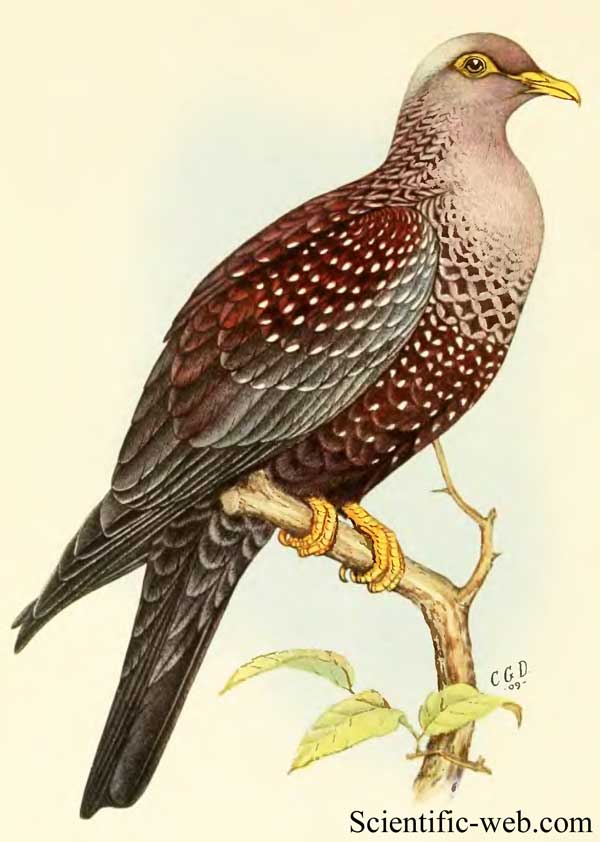
Columba arquatrix
Superregnum: Eukaryota
Cladus: Unikonta
Cladus: Opisthokonta
Cladus: Holozoa
Regnum: Animalia
Subregnum: Eumetazoa
Cladus: Bilateria
Cladus: Nephrozoa
Superphylum: Deuterostomia
Phylum: Chordata
Subphylum: Vertebrata
Infraphylum: Gnathostomata
Megaclassis: Osteichthyes
Cladus: Sarcopterygii
Cladus: Rhipidistia
Cladus: Tetrapodomorpha
Cladus: Eotetrapodiformes
Cladus: Elpistostegalia
Superclassis: Tetrapoda
Cladus: Reptiliomorpha
Cladus: Amniota
Classis: Reptilia
Cladus: Eureptilia
Cladus: Romeriida
Subclassis: Diapsida
Cladus: Sauria
Infraclassis: Archosauromorpha
Cladus: Crurotarsi
Divisio: Archosauria
Cladus: Avemetatarsalia
Cladus: Ornithodira
Subtaxon: Dinosauromorpha
Cladus: Dinosauriformes
Cladus: Dracohors
Cladus: Dinosauria
Ordo: Saurischia
Cladus: Eusaurischia
Subordo: Theropoda
Cladus: Neotheropoda
Cladus: Averostra
Cladus: Tetanurae
Cladus: Avetheropoda
Cladus: Coelurosauria
Cladus: Tyrannoraptora
Cladus: Maniraptoromorpha
Cladus: Maniraptoriformes
Cladus: Maniraptora
Cladus: Pennaraptora
Cladus: Paraves
Cladus: Eumaniraptora
Cladus: Avialae
Infraclassis: Aves
Cladus: Euavialae
Cladus: Avebrevicauda
Cladus: Pygostylia
Cladus: Ornithothoraces
Cladus: Ornithuromorpha
Cladus: Carinatae
Parvclassis: Neornithes
Cohors: Neognathae
Cladus: Neoaves
Cladus: Columbimorphae
Ordo: Columbiformes
Familia: Columbidae
Subfamilia: Columbinae
Genus: Columba
Species: Columba arquatrix
Name
Columba arquatrix Temminck, 1808
References
Les Pigeons, par Madame Knip, née Pauline de Courcelles, gravées, imprimées et retouchées sous sa direction: 11, pl.5.
Vernacular names
Afrikaans: Geelbekbosduif
العربية: حمام الزيتون الأفريقي
čeština: Holub olivový
dansk: Olivendue
Deutsch: Oliventaube
English: African Olive Pigeon
Esperanto: Oliva kolombo
español: Paloma ojigualda
eesti: Helmestuvi
فارسی: کبوتر زیتونی آفریقایی
suomi: Oliivikyyhky
français: Pigeon rameron
עברית: יונת זית אפריקנית
magyar: Afrikai olajgalamb
italiano: Colomba macchiata africana
日本語: オリアブバト
lietuvių: Alyvinis karvelis
Nederlands: Olijfduif
norsk: Gulbrilledue
polski: Golab zóltooki
پنجابی: زیتونی کبوتر
português: Pombo-d'olho-amarelo
русский: Оливковый голубь
slovenčina: Holub žltooký
svenska: Olivduva
Kiswahili: Hua Matembwe
Xitsonga: Ngalakana
Tiếng Việt: Bồ câu vàng lục châu Phi
isiXhosa: Izuba
中文: 黄眼鸽
isiZulu: iVukuthu-lehlathi
The African olive pigeon or Rameron pigeon (Columba arquatrix) is a pigeon which is a resident breeding bird in much of eastern and southern Africa from Ethiopia to the Cape. Populations also are found in western Angola, southwestern Saudi Arabia and northern Yemen. It is locally common, although sizeable gaps in its distribution occur due to its habitat requirements.
Description
The adult male African olive pigeon is a large pigeon at 37 to 42 cm (15 to 17 in) in length and a weight of 300 to 450 g (11 to 16 oz).[2][3][4] Its back and wings are maroon, with the shoulders heavily speckled with white spots. The underparts are maroon with heavy white spotting, and the head is grey with yellow patches around the eye, and a yellow bill. The neck plumage, used in display, is streaked maroon and white, the underwing and undertail are dark grey, and the feet are yellow.
Females are very similar but somewhat duller. Juvenile birds have the maroon and grey replaced with dark brown, the bare parts are a dull greenish-yellow, and the wing feathers have pale fringes. In flight, this pigeon looks very dark. Its flight is quick, with the regular beats and an occasional sharp flick of the wings which are characteristic of pigeons in general. The call is a loud coo coo.
Habitat
This is a species of cool, moist forest canopies above 1,400 m (4,600 ft) altitude, although it occurs locally as low as 700 m (2,300 ft). It will use mountain fynbos, second growth, and clearings, and feed on agricultural land when not persecuted.
Behaviour
Breeding
The African olive pigeon builds a large stick nest up to 15 m (49 ft) high in a tree and lays one (rarely two) white eggs. The eggs are incubated for 17–20 days to hatching, and the chicks fledge in another 20 days.
The male has a display consisting of deep bows, and a display flight which consists of a climb, wing clapping, and slow glide down.
Feeding
The African olive pigeon feeds on fruit and berries, mainly picked in the canopy, but it will also descend for fallen fruit and take some insects and caterpillars. In the south of its range, it favours the fruit of a highly invasive plant, the bugweed, Solanum mauritianum. Birds fly considerable distances from their roosts to feeding areas, and young or nonbreeding birds form flocks.
Geophagy has been observed in this species.[5]
References
BirdLife International (2016). "Columba arquatrix". IUCN Red List of Threatened Species. 2016: e.T22690145A93262374. doi:10.2305/IUCN.UK.2016-3.RLTS.T22690145A93262374.en. Retrieved 12 November 2021.
"Rameron (African olive) pigeon - Columba arquatrix : WAZA : World Association of Zoos and Aquariums". WAZA. Archived from the original on 2013-12-03. Retrieved 2012-08-24.
"African Olive Pigeon (Columba arquatrix fam. columbidae) Kruger Park Birds & Birding". Thekruger.com. 2010-09-15. Retrieved 2012-08-24.
Field Guide to the Birds of East Africa: Kenya, Tanzania, Uganda, Rwanda, Burundi by Stevenson & Fanshawe. Elsevier Science (2001), ISBN 978-0856610790
Dean, W. R. J. (2005). "African Olive Pigeon". In Hockey, P.A.R.; Dean, W. R. J.; Ryan, P. G. (eds.). Roberts Birds of Southern Africa (7th ed.). Cape Town: Trustees of the John Voelcker Bird Book Fund. p. 278. ISBN 0620340533.
Gibbs, Barnes and Cox, Pigeons and Doves (Pica Press 2001) ISBN 1-873403-60-7
Ian Sinclair, Phil Hockey and Warwick Tarboton, SASOL Birds of Southern Africa (Struik 2002) ISBN 1-86872-721-1
Retrieved from "http://en.wikipedia.org/"
All text is available under the terms of the GNU Free Documentation License

